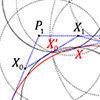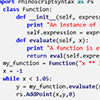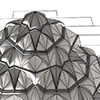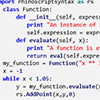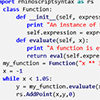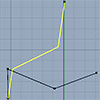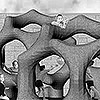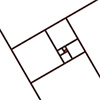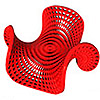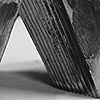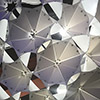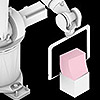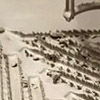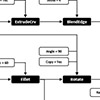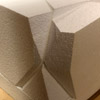This is a new paper published in Nexus Network Journal. I tried to implement euclidean constructions by compass in the approximation of famous parametric curves; Bézier curves, and B-Splines. Then, I created the algorithms to calculate the number of steps on a compass-only construction of Bézier curves. I developed a simple Python script to simulate the geometric constructions. However, I have been studying this topic for nearly four years. In […]
This is the continuation of my new project of re-creating the parametric curve and surface methods of Rhino via Python scripting. If you remember, I started with the building block of vector operations, here and here. Then, I defined vector addition and multiplication, before going deeper into the geometric calculations. In fact, they are using the previously defined addition and multiplication methods. New Vector Operations: Subtraction and Reversing In the […]
Together with Sevde Dinçer, we published a new study on the digital reconstruction of muqarnas. This is also Sevde’s ongoing Ph.D. topic. Previously, she started studying muqarnas geometry in her master thesis under the supervision of Togan Tong. Then, she advanced her studies in this field. Eventually, my contribution to this study was about redefining and comparing the three major modeling approaches. Apart from that, the case study, literature research, […]
Today, I am going to advance the Vector class a bit more. Firstly, I will improve the display method I introduced recently. Then, I will add two new methods which handle the fundamental vector arithmetics in Rhino Python. Improving the Display Method In the previous attempt, I displayed vectors on the origin of the Rhino viewport. The coordinates of the tail of a vector are not stored within the object […]
Let’s continue from the Vector class that started yesterday. Previously, I defined this class to store three numbers (coordinates), named as “components”. I defined a method named __init__ for this. Similarly, I am adding a display method to the Vector class today. Note that I am using Rhino 6 in this code, but it should also work in Rhino 5 or 7. The code Below is the line-by-line explanation of […]
In this new series, I will be using Rhino Python to create some of the fundamental mathematical objects in Rhino. We will learn how to code in Python, and also try to get deeper into the intuition behind some of the fundamental concepts we use every day in Rhino and Grasshopper. The Vector class in Rhino Python is the starting point of this journey. Just like vectors, most of the […]
This is a simple inverse kinematics solution developed by Andreas Aristidou and Joan Lasenby in 2011. They call it Forwards and Backwards Reaching Inverse Kinematics (FABRIK in short). It was quite interesting the learn this technique because it is a fast and accurate approximation of a kinematic chain. There are very interesting potentials of this technique in terms of architectural simulations. I tried to develop a Rhino Python script in […]
Below are some of the student works from the 2018 course: Design Mathematics. The final project of the course was about experimenting the designerly creativity. This included utilizing the mathematical concepts and objects studied throughout the semester. This was a rather open-ended homework question. But in the following years, I am not planning to repeat it. Because it becomes difficult to assess the learning outcome from open-ended homework within such […]
I like to deal with possible small computational geometry problems. These fun games are taking 2-3 hours. In addition, these are also memorable exercises. I was reviewing the Anemone plugin last week. I noticed that the Golden Ratio in Grasshopper was not geometrically generated before. Some of the greatest mathematical minds of all ages, from Pythagoras and Euclid in ancient Greece, through the medieval Italian mathematician Leonardo of Pisa and the Renaissance astronomer Johannes Kepler, to present-day scientific […]
In Design Mathematics 2019 course, Berke Çelik designed the Enneper Slide in his final project. The Enneper surface is an interesting case since it is a minimal surface with potential variations for spatial implementations. Berke used Rhino Math and Grasshopper / Weaverbird to generate his design. I think the Enneper Slide, as a minimal surface, is an exciting start for a Design Mathematics student work. But as always, much more […]
Today, I am introducing a student work from the Design Mathematics course. Foad Sarsangi is a very talented designer, who attended my elective course last semester. The final project he studied was inspired by Peter Zumthor’s Bruder Klaus chapel. Foad wanted to experience its special production process. However, as the course was about “mathematics”, he also studied, solved, and generated an interior volume to be subtracted from a solid mass. […]
This is a student project of the Computation-based Basic Design Lanterns finals of the year 2019. This year was exceptionally successful in creating 3d components and constructing relationships as a systematic whole. Again, the students started with small-scale experiments on folding and attaching cards. This is a study of how planar elements can generate volumetric units. They also studied Archimedean solids to understand geometric performances of particular shapes. We encouraged […]
This is a robotic fabrication student project developed in the Digital Fabrication elective course in 2018. This group of students experimented with the hot wire cutting of EPS foam. Their aim was to create curved surfaces by using a straight wire. Design research started with a literature study of precedents. Then, after several cutting experiments with the available hotwire cutter tool, they gained better control over the technology. However, they […]
I will try to explain the student project called KUKABAE that was developed in my Robotic Fabrication elective course in 2018. This was a very interesting project. Initially, the students were doing the design to attach an ordinary pen holder to the robot. but then the project changed by chance. they decided to replace a pen holder with a ceramic knife. As seen in the video and pictures, the relationship […]
Here is a design exercise I’ve been giving to students. It aims to familiarize students with the concept of dataflow diagrams used in Grasshopper. Dataflow is a different concept than conventional computer programming. Here is a good comparison between control flow and dataflow languages. In most educational settings (such as courses and workshops) we concentrate on the fundamental issue of dataflow management via design projects. This requires us to think […]
As the design of free-form architectural surfaces becomes easier, questioning and foreseeing the feasibility of the construction of these surfaces becomes important. Such an inquiry requires sufficient knowledge of architectural geometry besides the knowledge of materials and structural systems. In this article, we present a preliminary example of a guide. It supports the design and production process of building surfaces with different geometric properties is presented. This guide aims to […]
Today, we have studied creating complex robot programs manually again. Platonic solids were the subject of this study. Students tried to create a sequence of robot moves that produces a Platonic solid out of a 17cm EPS cube. We simply call this the robotic hotwire cutting polyhedra exercise. However, the size of our hotwire cutter became one of the problems because of its risk of crashing. We crashed several times […]

